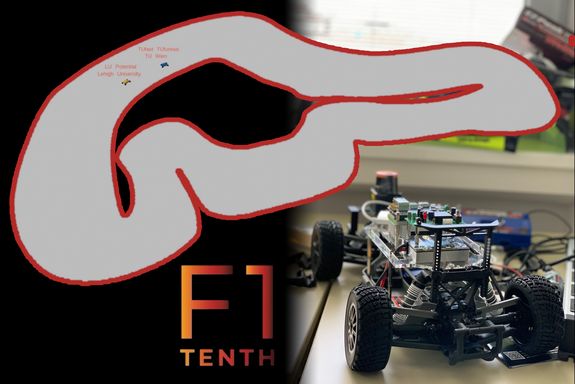Totally autonomous, without any external intervention, only with carefully developed artificial intelligence – this is how the racing cars have to compete against each other in the "F1/TENTH" competitions. Since 2016, students and research teams from universities all over the world have been competing to develop the best software to leave the competition behind on a model race track.
Up to now, the teams have always been given the same physical platform - a 1:10 scale model racing car. Therefore, the focus of the competition is entirely on the algorithms developed by the teams. This year, the F1/TENTH Grand Prix was held as part of the International Federation of Automatic Control (IFAC) World Congress in Berlin. Due to the corona pandemic, this conference was held online, and therefore it was decided to hold the Grand Prix virtually as well: The programming task remained the same, but instead of controlling physical model cars, the algorithms were pitted against each other in a virtual environment.
From the TU Wien course to the race track
The team "TU fast TU furious" was created by the course "Autonomous Racing Cars master course", taught by Prof. Radu Grosu from the Institute for Computer Engineering at TU Wien. This course is unique in Austria, and one of few comparable courses in Europe: The course material (cameras, optical distance measurement technology, processors, etc.) was funded by the BMBWF infrastructure project CPS/IoT, which is intended to prepare Austria for the upcoming digital revolution.
For one semester, the students developed control codes based on deep learning algorithms. "From the most motivated of them, we then formed the TU team to compete against world-renowned universities, including MIT, UC Berkley and Stanford, or UPenn, who originally initiated the competition," says Radu Grosu.
The TU team eventually consisted of Thomas Pintaric (team leader), Mathias Lechner (IST Austria), Bernhard Schlögl, Axel Brunnbauer, and Andreas Brandstätter. Team consultants were Ramin Hasani, and Radu Grosu, also from the Institute for Computer Engineering, TU Wien.
"Based on the knowledge conveyed in our course, the team managed to develop a smart autonomous agent to steer the car," says Radu Grosu. "A whole range of algorithms and control strategies were tested before we decided on the best variant, which eventually won." For the algorithms themselves, it didn't matter if they were controlling a physical car or if they were in a purely virtual world, as was the case in this edition of the F1/TENTH Grand Prix.
The competition
The geometry of the race track was specified by the race management. The electronic agents then had to calculate an optimal path, and then apply various control strategies to keep their vehicle on that path. In a preliminary round, obstacles were placed on the course, which the autonomous vehicles had to avoid. "We didn't want to reveal anything about our strategy at this stage. So we put our focus on safety here and drove down the track very slowly. Without a crash, we were qualified for the main event, albeit with the slowest time," says team manager Thomas Pintaric.
Finally, on the main day of competition, the eight remaining teams competed against each other in pairs. "TU fast TU furious" won seven of the eight races and finally secured first place on 15 July 2020.
"Essentially, you needed three important components to win," says team member Mathias Lechner. "A good lap time, solid collision avoidance and aggressive tactics at the start. All teams managed to implement one or two of these points well. But only our team could reliably combine all three."
"This is a great success for us - especially considering the fact that it was the first time that TU Wien participated in the F1/TENTH competition", says Radu Grosu. "It was certainly not the last time. It shows that TU Wien has incredibly talented students who can successfully compete with teams from the best universities in the world".
Contact
Prof. Radu Grosu,
Institute for Computer Engineering
TU Wien
T: +43-1-58801-18210
radu.grosu@tuwien.ac.at
Dr. Ramin Hasani
Institute for Computer Engineering
TU Wien
T: +43-1-58801-18228
ramin.hasani@tuwien.ac.at
